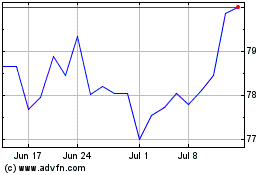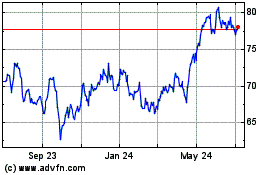Southern Co.'s New 'Clean Coal' Plant May Not Be Cost-Efficient -- Update
February 22 2017 - 5:26PM
Dow Jones News
By Russell Gold
Southern Co. said it has nearly completed a first-of-its-kind
"clean coal" power plant, though a new analysis suggests it might
not make sense to burn coal in it.
After taking nearly seven years and $7.1 billion to build, the
Kemper County, Miss., facility, which can burn coal and capture
much of the carbon-dioxide output, should be fully operational by
the middle of next month, the company said.
But a required economic analysis of the project, the most
expensive fossil-fuel power plant ever built in the U.S., found
that lower natural gas prices and higher-than-expected operating
costs "negatively impact the economic viability" of the
facility.
The company analysis, disclosed this week, concludes that only
if natural gas prices are high would the economics of the
clean-coal plant compare favorably to a gas-burning plant. The
Kemper facility was initially forecast to cost $3 billion in
2010.
Southern updated the status of the troubled plant as it posted a
sharp decline in profit in the final quarter of 2016 to $197
million, or 20 cents a share, down from $271 million, or 30 cents,
a year prior. It said its earnings were helped by retail revenue at
its traditional electric operating companies and weather-related
revenue impacts, but offset by higher operations and maintenance
costs, increased share issuances and lower customer usage.
The company declined to specify the gas price assumptions it
used in its scenario for the Kemper plant's viability, but said on
a conference call with investors Wednesday that the scenario
included a price above $5 per million British thermal units in 2020
and trending upward.
By comparison, the U.S. Energy Information Administration's
forecast doesn't anticipate gas prices to top $5 until 2030.
Southern Chief Executive Thomas Fanning said that in 2010, it
had promised to build a plant that would be a hedge against rising
gas prices.
"I cannot imagine the company is going to be held accountable
for a changing gas-price forecast," he said.
The project looks to be a very expensive hedge. If Southern had
built a natural gas power plant of comparable size, it would have
cost about $700 million -- one-tenth of the facility's overall
cost, according to widely used capital construction cost
estimates.
Southern is now headed toward a showdown over who should pay for
the plant's extra costs.
It plans to ask state officials to approve passing on $4.2
billion in costs to ratepayers of Mississippi Power. But the
company has critics who contend the plant was ill conceived and
poorly executed, and are expected to ask regulators to approve only
a portion of those costs.
In recent weeks, Chevron Corp., which owns and operates a large
refinery in southeastern Mississippi, has made several filings
questioning the plant's price tag, which has more than doubled
since 2010. Chevron would be among the ratepayers who could be
asked to bear the costs of the facility.
Southern already faces a lawsuit over the plant and an
investigation by the Securities and Exchange Commission.
Charles Grayson, a retired chemical industry executive in
Brandon, Miss., and a critic of the plant, says he thinks
Southern's estimates about operations remain overly optimistic.
"For the plant to have a chance to be economical, you need
natural gas prices to go way higher than anyone is anticipating and
you have to have very high reliability year in and year out," he
said.
The Kemper plant was proposed as a showcase of clean-coal
technology. It can turn locally mined coal into a synthetic gas,
capturing the majority of the carbon dioxide. It plans to sell the
carbon dioxide to oil companies that will inject it into older oil
fields to extract more hydrocarbons.
At the time the facility was conceived, few predicted the impact
that added natural gas supplies would have on the economics of U.S.
electricity production. Government and business officials were also
eager to test technology to burn inexpensive coal while limiting
the carbon dioxide emissions.
Mr. Fanning said Wednesday that he was glad the Kemper facility
was close to finished.
"It has been a painful process. Getting to this point we
certainly have taken our lumps," he said.
--Anne Steele contributed to this article.
Write to Russell Gold at russell.gold@wsj.com
(END) Dow Jones Newswires
February 22, 2017 17:11 ET (22:11 GMT)
Copyright (c) 2017 Dow Jones & Company, Inc.
Southern (NYSE:SO)
Historical Stock Chart
From Mar 2024 to Apr 2024

Southern (NYSE:SO)
Historical Stock Chart
From Apr 2023 to Apr 2024
